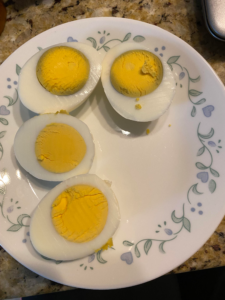
Finding green yolks in your hard-boiled eggs can be unsettling. This discoloration, while usually harmless, has specific causes and implications. Understanding why this happens and whether it affects the safety of your eggs can help you make informed decisions about your meals.
Why Do Hard-Boiled Eggs Have Green Yolks?
- Overcooking: The most common reason for green yolks is overcooking. When eggs are boiled for too long, sulfur in the egg whites reacts with iron in the yolks, creating a greenish or grayish color. This reaction forms iron sulfide, which causes the discoloration.
- High Temperature: Boiling eggs at too high a temperature can exacerbate the reaction. Rapid boiling can cause the sulfur and iron compounds to react more quickly, leading to a green hue on the yolks.
- Egg Freshness: Older eggs are more likely to develop greenish yolks when hard-boiled. As eggs age, their pH level increases, making it easier for the sulfur and iron to react during cooking.
- Acidity: The pH level of the water used for boiling can also influence the color change. Very alkaline or very acidic water might enhance the formation of iron sulfide.
Is It Safe to Consume Green Yolks?
Yes, eggs with green yolks are generally safe to eat. The green color is a result of a chemical reaction, not a sign of spoilage or contamination. However, here are a few considerations:
- Nutritional Value: The green coloration does not affect the nutritional value of the egg. The egg remains rich in protein and other nutrients.
- Texture and Taste: Overcooked eggs might have a slightly altered texture and taste. They can become dry and crumbly compared to perfectly cooked eggs.
How to Prevent Green Yolks
- Cook Eggs Properly: To avoid green yolks, cook eggs for the correct amount of time. Boil them for about 9 to 12 minutes, depending on size. A lower, steady simmer can also help prevent overcooking.
- Cool Quickly: After boiling, transfer eggs to an ice bath or run them under cold water. This stops the cooking process and reduces the likelihood of green yolks.
- Use Fresh Eggs: Fresh eggs are less likely to develop green yolks. If possible, use eggs that are not too old for boiling.
- Control Temperature: Boil eggs at a gentle simmer rather than a rolling boil to minimize the risk of overcooking.
Conclusion
Green yolks in hard-boiled eggs are usually harmless and result from overcooking or high temperatures. While they do not pose a health risk, adjusting your cooking methods can help prevent this discoloration. By boiling eggs properly and cooling them quickly, you can ensure that your hard-boiled eggs remain visually appealing and delicious.